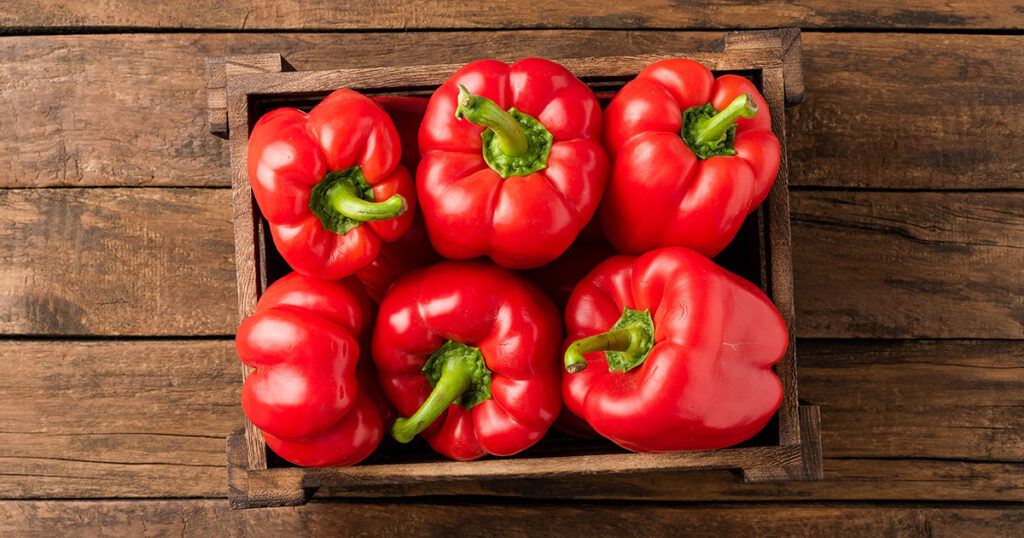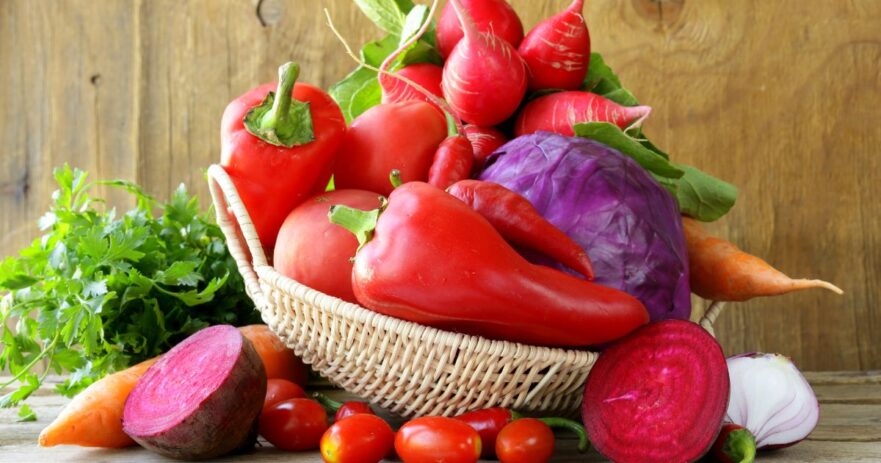When we think of vegetables, green is often the color that comes to mind. Yet, the world of nutrition and visual delight extends beyond these verdant hues, encompassing the vibrant realm of red vegetables. These red gems aren’t just visually enticing but are full of vital nutrients that do wonders for our health. From the gentle sweetness to the hearty, earthy tones, including red vegetables in your meals means adding both taste and wellness. Let’s delve into the spectrum of red and discover how these veggies can be a delicious and nutritious part of our daily fare.
What are red vegetables?
Red vegetables are a group of plant-based foods characterized by red, crimson, or deep pink coloration [1]. These colors are attributed to the presence of various pigments, such as lycopene and anthocyanins, which not only lend the vegetables their distinctive hue but also offer a range of health benefits [2].
Key Takeaways
- Lycopene in tomatoes and the antioxidant content in red carrots may help protect against heart diseases. [3][13]
- Amaranthus offers unique compounds that combat free radicals and have potential health benefits. [12]
- Radishes and rhubarb contribute to digestion and gut health, aiding in managing conditions like diabetes and inflammation. [6][7]
10 Healthy and Delicious Red Vegetables
Red Pepper
Red peppers, scientifically known as Capsicum annuum, belonging to the Solanaceae family, originate in South America. They were valued for both their culinary and medicinal benefits. Many studies have highlighted how red peppers and their active component, capsaicin, can help manage conditions like high cholesterol, hypertension, diabetes, and obesity. These peppers can potentially address issues related to metabolic syndrome, such as weight problems, disrupted lipid profiles, and diabetes-related complications. Beyond being a food enhancer, traditional medicine has utilized red peppers to treat various concerns like coughs, sore throat, toothaches, arthritis, and even as a wound healer [8].

Tomato
Tomatoes play a crucial role in a healthy diet, and they can be enjoyed whether eaten raw or cooked without losing their nutritional goodness. Having tomatoes and tomato-based products in your diet comes with several health perks; a big reason is their antioxidant content. These red gems might even help keep heart issues at bay—studies have shown connections between tomato consumption and lower chances of atherosclerosis. Lycopene, a red pigment in tomatoes, is a top-notch antioxidant [3]. Tomatoes contain various essential nutrients, including vitamins, minerals, fiber, protein, necessary amino acids, carotenoids, and phytosterols. These nutrients step up for tasks like preventing constipation, easing high blood pressure, boosting blood flow, maintaining our body’s lipid profile and fluids, and getting rid of toxins. [9]
Red Carrot
Red carrots have a special ingredient called lycopene, also found in tomatoes and believed to act as a shield for our hearts, helping keep heart disease away [13]. These red carrots don’t just stop at being delicious; they’re also considered a functional food. They bring along essential vitamin A, and on top of that, they might help protect us from chronic diseases because of the potential benefits of lycopene [11]. Moreover, red carrots bring some extra antioxidants to the table compared to their orange, yellow, and white counterparts. Plus, when the rain isn’t that much during the growing season, they gather even more of these good things called phenolic compounds .[4]
Red Cabbage
Red cabbage, scientifically Brassica oleracea L. var. capitata L. f. rubra, is a cool-season leafy veggie in the Brassicaceae family. It’s a versatile delight in salads, slaws, soups, and more. Its captivating red or purple heads owe their hues to anthocyanin pigment. Beyond its deliciousness, red cabbage is a chemical powerhouse with medicinal potential. Packed with phytochemicals, antioxidants, and vitamins (C, E, A, and K), it also brings essential minerals (calcium, manganese, magnesium, iron, and potassium) while staying low on unhealthy fats and cholesterol. B vitamins like thiamine (B1), riboflavin (B2), and folate (B2) are in on the action too. Notably, red cabbage might help shield us from cancer, aging, diabetes, ulcers, and Alzheimer’s while aiding weight loss, boosting immunity, enhancing skin and eye health, and detoxifying the body. [5]
Amaranthus
Amaranthus is also known as red amaranth. The red morph of amaranth, rich in nutrients, antioxidant pigments, minerals, and phytochemicals, outshines the green morph. Its array of color pigments, including β-cyanins, β-xanthins, betalains, and more, combat free radicals and act as robust antioxidants. These pigments, backed by anti-inflammatory powers, offer defense against lung, skin disorders, and heart ailments. These natural pigments also find roles in cosmetics, drugs, and food. [12]
Moreover, in a 100g serving, red amaranth delivers water (91.7g), protein (2.46g), calcium (215mg), magnesium (55mg), phosphorus (50mg), potassium (611mg), vitamin C (43.3mg), vitamin A (146µg RAE / 2920 IU), and vitamin K (1140µg) (10). Diverse red morph amaranth germplasms in regions like Bangladesh, Asia, Africa, and South America come with versatile uses. [12]
Red Beet
Red beetroot, scientifically known as Beta vulgaris rubra, has emerged as a noteworthy health-promoting functional food [14]. Grown across the Americas, Europe, and Asia, it’s commonly consumed as a vegetable, juice, or even as a powder for food coloring [15]. These beetroots exhibit varying shapes from globular to tapered, making them versatile for culinary uses like raw consumption, salads, soups, roasting, and inclusion in various dishes with olive oil [16]. Packed with beneficial bioactive elements like betalains, polyphenols, antioxidants, vitamins, carotenoids, flavonoids, minerals, and ascorbic acid, red beetroots offer diverse therapeutic effects tied to their biochemical richness. Remarkably, they rank among the top antioxidant-rich vegetables due to betalains, accentuating their nutritional prowess. [16]
Radish
Radish (Raphanus sativus), a root vegetable widely cultivated and enjoyed globally, holds a significant place in human diets. People relish its crisp texture by consuming it raw, commonly in salads. This versatile vegetable offers a range of nutrients: carbohydrates, sugars, dietary fibers, proteins, and even a touch of fat and fluoride. It’s a nutrient powerhouse containing water-soluble vitamins (B1, B2, B3, B5, B6, B9, and C) and essential minerals (calcium, iron, magnesium, manganese, zinc, potassium, and phosphorous). Studies have highlighted radish’s potential to aid diabetes management by bolstering antioxidant defenses and reducing oxidative stress—an imbalance between harmful reactive oxygen species and protective antioxidants in our cells [6]. Notably, water-soluble radish extract aids in lowering blood sugar response, while fat-soluble extract contributes to lipid metabolism.
Red Chicory
Red chicory (Cichorium intybus L. cultivar) is emerging as a nutritional powerhouse among vegetables, mainly due to its robust content of phenolic compounds, notably anthocyanins. The presence of these anthocyanins is particularly intriguing as they’ve been associated with a range of health perks, including promoting visual capacity, cognitive function, weight management, and reducing cardiovascular risk. [17]
This plant isn’t just a nutritional hero; it also holds commercial significance, being cultivated across Asia, North America, and Europe. Beyond its nutritional assets, red chicory holds a hidden treasure—bitter compounds like sesquiterpene lactones—showcasing antimalarial, anthelmintic, and antimicrobial potentials [18]. All in all, red chicory combines flavor and health benefits in a single, vibrant package.
Rhubarb
Rhubarb, a historic and valuable herb, boasts thick roots, upright stems, and small white-green or purple-red flower clusters on its branches. While it has a rich history in medicine, rhubarb’s contributions extend far beyond. This wonder herb offers a range of pharmacological activities, including anti-tumor effects, regulation of gut flora, anti-bacterial action, combating inflammation, and impeding fibrosis. Rhubarb doesn’t hold back when tackling bacteria; it efficiently fights off various types, from Staphylococcus aureus to Helicobacter pylori. How does it work? Rhubarb takes down Staphylococcus aureus by disrupting its cell wall and altering the cell membrane’s structure. Particularly notable is rhubarb’s effect on our digestive system—it aids digestion by assisting the breakdown of leftover food. [7]
Red Onion
Red onions (Allium cepa L.) are kitchen staples in many cuisines, bringing flavor and more to the table. These onions, alongside other Allium species, carry more than just taste—they’re believed to pack medicinal goodness, including antioxidants. What’s handy is that these Allium wonders can be dried and kept for months without losing their essence. Thanks to their antibacterial and antifungal properties, these onions are no strangers to battling bacteria and fungi. They’re not stopping there; they’re also loaded with robust antioxidants like sulfur and various phenolic compounds. The interest they’ve stirred in the food industry is pretty telling. Over the past few decades, these Allium stars have been in the spotlight, captivating researchers and food enthusiasts alike. [19]
10 Healthy and Tasty Red Vegetables You Should Have in Your Diet
This article delves into the world of red vegetables, highlighting their diverse benefits and flavors. These crimson-hued delights are rich in essential nutrients, antioxidants, and bioactive compounds. From the fiery red pepper to the versatile tomato, each vegetable brings unique advantages to the table. Whether it’s the heart-protective lycopene in tomatoes or the digestion-enhancing properties of red cabbage, these vegetables offer a range of health perks. Their vibrant colors signify the presence of valuable phytonutrients, making them a valuable addition to a balanced diet. Incorporating these red vegetables into your meals can contribute to both taste and well-being.
FAQ
Which vegetables taste good and healthy?
Red bell peppers, tomatoes, and beets are tasty and nutritious red vegetables. They provide vitamins, antioxidants, and fiber, promoting overall health and well-being. [3][8][16]
What are red vegetables good for?
Red vegetables are rich in antioxidants, vitamins, and fiber, supporting heart health and immunity and reducing the risk of chronic diseases. [5][12][13][16]
What is the healthiest red food?
Tomatoes are often considered one of the healthiest red foods. They're packed with lycopene, a powerful antioxidant linked to various health benefits, including heart health and chronic disease prevention. [3]
What is the healthiest red vegetable?
Red bell peppers are often considered one of the healthiest red vegetables. They're rich in vitamins A and C, antioxidants, and fiber, supporting immune function, skin health, and overall well-being. [20]

